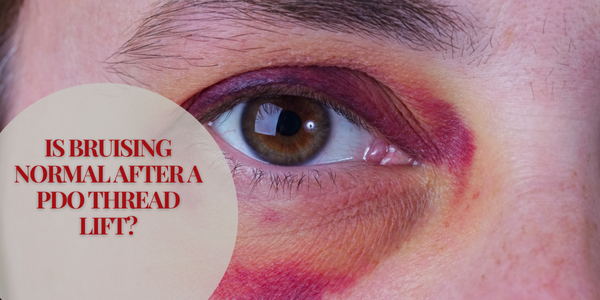
There are many advantages that PDO thread lifts offer over alternative cosmetic treatments. They are affordable and accessible, customizable to your specific anti-aging needs, quick and painless, and produce amazing results.
In addition, there is very little downtime and recovery time associated with a PDO thread lift. While your provider will give you a list of post-care instructions, they aren’t too limiting. In fact, you will be able to resume most of your normal daily activities the moment you leave the office.
Of course, because a PDO thread lift does involve inserting something into your skin, there are some ways in which it will affect you. Many of these, though, are due to the body’s natural response to a foreign object being inserted into it and the natural processes it uses to heal.
If you’ve never had a PDO thread lift before, you might be wondering whether bruising is normal after a treatment. In this article, we’ll discuss this topic in more depth so you can know what to expect in the days following your procedure.
After the procedure is over, you may experience some bruising and/or swelling in the treatment area. This is completely normal and is your body’s way of starting the healing process.
 Medically reviewed by: Elizabeth Williams RN
Medically reviewed by: Elizabeth Williams RN
Updated: 7/15/2025
How Do PDO Thread Lifts Work?
PDO threads are thin threads that are made from a synthetic material that is 100% biocompatible and biodegradable. This means that there’s a very low chance for major risks, and your body will use natural processes to break them down over time.
PDO threads have been used in surgical procedures as dissolvable sutures for many years, thanks in large part to their strength and the fact that they don’t have to be removed.

The threads that are used for lifting procedures have barbs on the end of them, which grab onto parts of your skin and lift it up. Your provider will position these threads perfectly in your skin to achieve your desired outcome.
PDO thread lifts are used to address common aging concerns such as sagging and drooping skin, fine lines and wrinkles, and lack of definition.
After they are inserted, your body will produce extra collagen in the treatment area to help break the threads down. This, in turn, helps to extend the life of the results and also leaves your skin more elastic, plump and youthful looking.
| Benefits | Common Side Effects |
|---|---|
| Minimally invasive procedure | Mild bruising or swelling |
| No general anesthesia required | Temporary tenderness at insertion sites |
| Quick recovery — most daily activities resume same day | Slight tugging or pressure sensations |
| Stimulates collagen for long-term skin improvement | Minor discomfort during healing phase |
| Customizable for various skin types and concerns | Small risk of thread visibility or irregularity (rare) |
Is Bruising Normal After a PDO Thread Lift?
PDO thread lifts are considered minimally-invasive cosmetic treatments. You don’t need to go “under the knife” or have general anesthesia for them to be performed.
Your provider will likely use local numbing agents to ensure you are fully comfortable before the procedure begins. Once you are, they will insert the PDO threads into their proper place. You may feel a slight tugging and/or pressure while this is happening, but you shouldn’t feel any pain.
After the procedure is over, you may experience some bruising and/or swelling in the treatment area. This is completely normal and is your body’s way of starting the healing process.
Bruising happens anytime that capillaries — which are small blood vessels located under your skin — are damaged, and this usually happens when your provider is inserting the needle and PDO threads into your face. It’s nothing to be concerned about, just like other bruises that might happen if you bang your arm isn’t.
In most cases, the bruising and swelling will resolve itself on its own in a few days’ to a week’s time following your PDO thread lift. You can help alleviate any pain or discomfort associated with the bruising by applying ice packs and taking certain over-the-counter medications.
That being said, it’s important to pay attention to your provider’s post-care instructions, as you will likely be advised to avoid certain medications for the first few weeks after a PDO thread lift due to their propensity to obstruct the normal healing process.
Get a PDO Thread Lift with V Soft Lift’s High-Quality Products
Bruising is completely normal after a PDO thread lift. In fact, most people will experience some level of bruising and/or swelling after such a treatment, though it usually will be minor in nature.
If you experience excessive bruising or swelling after a PDO thread lift and/or the bruising and swelling doesn’t subside or go away after about a week, it’s best to consult with your provider to see if you’re experiencing any issues.
One way you can reduce the risk of something going wrong with a PDO thread lift is to choose a trusted, reputable and experienced provider who uses high-quality threads such as those produced by V Soft Lift.
We have created a long line of PDO threads that allow providers to select the ones that are best for each treatment and skin type, ensuring the best possible results for every patient.
For more information, contact us today.
